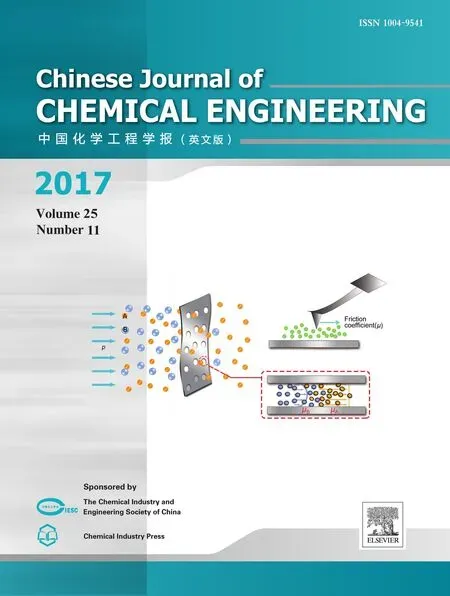Preface to Special Issue of Membranes and Membrane Processes based on Confined Mass Transfer
Membrane separation is playing an increasingly critical role in diverse fields as a cost-efficient and energy-economic technology.Ultrafiltration and micro filtration based on the size-sieving mechanism of macroporous media have been clearly elucidated using classical theories of mass transfer.However,membrane processes including pervaporation,gas separation,ion exchange,nanofiltration,reverse osmosis,etc.,mainly involve mass transfer in narrow spaces whose sizes are comparable to the free distances of molecules mobility,i.e.,confined mass transfer.Currently,it is not fully understood for the confined mass transfer in these membranes,and consequently such membranes are mainly empirically manufactured.
Aiming to explore the confined mass transfer mechanism,engineer the precise membrane structure and achieve the efficient separation processes,two major programs have been launched in China.(1)Major Program of National Natural Science Foundation of China(No.21490580):Precise engineering and efficient applications of membranes based on the mechanism of confined mass transfer.(2)National Program on Key Basic Research Project(973 Program,No.2015CB655301):Application-oriented design and fabrication of high-performance membranes for water treatment.Modeling and simulation are coupled with experiments to reveal the principles of mass transfer under confinement and to establish the theoretical models.On the basis of that,the formation mechanism and tuning methods of membrane pores are investigated,the membrane pore structures are engineered to achieve high-efficiency molecular and ionic separation.With the implementation of the two major programs,it is expected to make theoretical innovation and technical progress in the separation science and engineering.
This special issue involves 11 articles(10 review articles and 1 research article),intending to summarize the advanced developments and perspectives about high-performance membranes based on the mechanism of confined mass transfer and their applications in related membrane processes.Lu et al.discussed the flow-resistance of fluids in the nano-confined space by focusing on the friction coefficient inspired from liquid nano-lubrication[1].The progresses of new membrane materials including mixed-matrix membranes[2,3]and graphene-based membranes were reviewed,with particular attention on discussing the confined mass transfer structure[4].Construction of membrane structures and their applications involving confined mass transfer such as ion separation[5],pervaporation[6,7],nanofiltration[8,9],reverse osmosis[10]were summarized in this special issue.We hope that this special issue not only introduces recent researches of membranes based on confined mass transfer to the greater scientific community,but also provides an incentive to draw more research interest in confined mass transfer from all over the world.
The Guest Editors are grateful to all the authors for their excellent contributions and the referees for their dedication.Our sincere gratitude also goes to the Chinese Journal of Chemical Engineering editorialteamfor their efforts and support to publish this special issue.
[1]X.Z.Huang,Y.D.Zhu,X.H.Lu,Flow-resistance analysis of nano-confined fluids inspired from liquid nano-lubrication:A review,Chin.J.Chem.Eng.25(11)(2017)1552-1562.
[2]W.D.Li,Z.Y.Jiang,Construction of molecule-selective mixed matrix membranes with confined mass transfer structure,Chin.J.Chem.Eng.25(11)(2017)1563-1580.
[3]M.Wang,Z.Wang,S.C.Wang,Recent advances on mixed matrix membranes for CO2separation,Chin.J.Chem.Eng.25(11)(2017)1581-1597.
[4]Z.Liu,L.Y.Chu,Graphene-based membranes for molecular and ionic separations in aqueous environments,Chin.J.Chem.Eng.25(11)(2017)1598-1605.
[5]L.Ge,T.W.Xu,Monovalentcation perm-selective membranes(MCPMs):new developments and perspectives,Chin.J.Chem.Eng.25(11)(2017)1606-1615.
[6]J.Zhao,W.Q.Jin,Manipulation of confined structure in alcohol-permselective pervaporation membranes,Chin.J.Chem.Eng.25(11)(2017)1616-1626.
[7]C.Zhang,L.Peng,J.Jiang,X.H.Gu,Mass transfer model,preparation and applications of zeolite membranes for pervaporation dehydration:a review,Chin.J.Chem.Eng.25(11)(2017)1627-1638.
[8]Y.L.Ji,Y.Zhou,C.J.Gao,Recent developments in nanofiltration membranes based on nanomaterials,Chin.J.Chem.Eng.25(11)(2017)1639-1652.
[9]S.K.Lim,R.Wang,Polymer-based membranes for solvent-resistant nanofiltration:A review,Chin.J.Chem.Eng.25(11)(2017)1653-1675.
[10]J.Li,M.J.Wei,Y.Wang,Substrate matters:The influences of substrate layers on the performances of thin- film composite reverse osmosis membranes,Chin.J.Chem.Eng.25(11)(2017)1676-1684.
 Chinese Journal of Chemical Engineering2017年11期
Chinese Journal of Chemical Engineering2017年11期
- Chinese Journal of Chemical Engineering的其它文章
- Positively charged nanofiltration membrane fabricated by poly(acid-base)complexing effect induced phase inversion method for heavy metal removal☆
- Substrate matters:The influences of substrate layers on the performances of thin- film composite reverse osmosis membranes☆
- Polymer-based membranes for solvent-resistant nanofiltration:A review
- Recent developments in nanofiltration membranes based on nanomaterials☆
- Mass transfer model,preparation and applications of zeolite membranes for pervaporation dehydration:A review☆
- Manipulation of confined structure in alcohol-permselective pervaporation membranes☆
